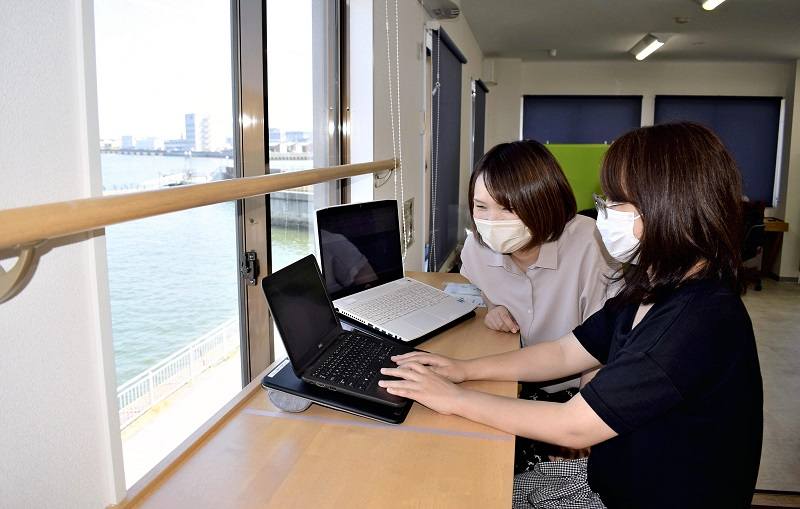
Staffers at the Komatsushima work support center participate in an online discussion in Komatsushima, Tokushima Prefecture, on Aug. 3.
16:25 JST, August 10, 2022
As the fall in Japan’s population picks up pace, some regional areas are hoping digital-related jobs could help them to buck this trend by attracting new residents.
According to figures released Tuesday by the Internal Affairs and Communications Ministry, the number of Japanese in the nation as of Jan. 1 decreased by a record-high 619,140, or 0.5%, from the previous year to 123,223,561, for the 13th consecutive year of decline. The population continues to fall in regional areas, and local authorities are pouring greater resources into efforts to arrest — and reverse — this trend.
This was the first time the population had dropped year-on-year by more than 600,000 people. In 2021, Japan’s population declined by more than the entire population of Tottori Prefecture (547,318 people).
Resident foreigners also decreased to 2,704,341, logging a fall for the second straight year due to stricter border controls during the novel coronavirus pandemic.
According to the ministry figures based on basic resident register data, the number of births dipped to 812,036 and marked a record low for the sixth straight year. Observers believe some people put off having babies during the pandemic, a move compounded by a fall in registered marriages, which is strongly correlated with the number of births. Only 501,116 marriages were registered in 2021, the fewest since the end of World War II. A record-high 1,441,739 people died in 2021, resulting in a natural decline — when the number of deaths exceeds the number of births — of 629,703 people for Japan’s population, another record high.
Okinawa Prefecture was the only one of Japan’s 47 prefectures that recorded a population increase. Tokyo posted a drop for the first time in 26 years. The population of the greater Tokyo area, which also includes the adjoining prefectures of Saitama, Chiba and Kanagawa, had been steadily rising in recent years, but fell 0.1% in 2021 to mark its first decrease since such records began in 1975.
The populations of 11 prefectures recorded a “social increase,” in which the number of people moving in tops the number of people moving out. Tokyo’s social increase of 12,841 people was down significantly from the 60,501 reported the previous year. This apparently was a result of, among other factors, more employees working from home during the pandemic, which blunted the flow of people into the capital.
Teaching new skills
The rates of population decrease were especially pronounced in regional areas, with the highest falls recorded by Akita Prefecture (1.51%) and Aomori Prefecture (1.32%). These figures once again demonstrated that efforts to stop population decline in these areas are failing to make an impact.
Tokushima Prefecture’s population declined 1.07% in 2021. The population of the city of Komatsushima in the prefecture peaked at about 44,000 in 1985, but has been trending downward since then and in 2021 shrank by 506 people (1.37%) from the previous year. Many local governments have tried to either maintain or boost their populations by taking steps such as inviting companies from major urban areas and encouraging them to build factories. “However, initiatives to attract companies have their limits,” Komatsushima Mayor Toshio Nakayama told The Yomiuri Shimbun.
The city has teamed up with Share X Inc., a company based in Kanagawa Prefecture that provides reskilling services by helping workers learn new and essential skills and knowledge, especially in the digital field. This tie-up has a simple aim. “We want people to acquire more digital skills, so they can continue their high-paying jobs from the city while living in Komatsushima,” Nakayama said.
Okinawa Prefecture, which bucked the trend of population decline, has this year boosted its support for start-ups involved in digital-related fields. This program was initially launched with the objective of breathing life back into a shopping district in Okinawa City that was losing tenants. “A growing number of people who have moved here do jobs that can be done remotely,” a prefectural government official said.
The Cabinet of Prime Minister Fumio Kishida has been pushing a Vision for a Digital Garden City Nation, which aims to revitalize regional areas through digital technology, and supporting local governments making efforts in this field. However, it remains unclear whether the increased use of digital technologies will be effective in halting the flow of people moving from rural areas to large cities.
“Addressing this issue will require a multipronged approach,” said Tottori University Prof. Kazunobu Tsutsui, an expert in rural geography. “In addition to incentive plans that create digital-related jobs in rural areas, we also need to ensure these regions have infrastructure capable of accommodating the people moving in as new residents, as well as the people moving back after years away.”
"Society" POPULAR ARTICLE
-

M4.9 Earthquake Hits Tokyo, Neighboring Prefectures
-

Israeli Tourists Refused Accommodation at Hotel in Japan’s Nagano Pref., Prompting Protest by Israeli Embassy and Probe by Prefecture
-

M7.5 Earthquake Hits Northern Japan; Tsunami Waves Observed in Hokkaido, Aomori and Iwate Prefectures
-

Tsukiji Market Urges Tourists to Avoid Visiting in Year-End
-

M5.7 Earthquake Hits Japan’s Kumamoto Pref., Measuring Upper 5 Intensity, No Tsunami Expected
JN ACCESS RANKING
-

Tokyo Economic Security Forum to Hold Inaugural Meeting Amid Tense Global Environment
-

Keidanren Chairman Yoshinobu Tsutsui Visits Kashiwazaki-Kariwa Nuclear Power Plant; Inspects New Emergency Safety System
-

Imports of Rare Earths from China Facing Delays, May Be Caused by Deterioration of Japan-China Relations
-

University of Tokyo Professor Discusses Japanese Economic Security in Interview Ahead of Forum
-

Japan Pulls out of Vietnam Nuclear Project, Complicating Hanoi’s Power Plans






















